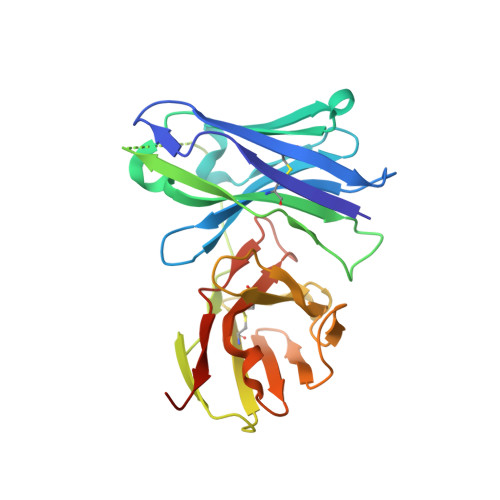Structural characterization of a therapeutic anti-methamphetamine antibody fragment: oligomerization and binding of active metabolites.
Peterson, E.C., Celikel, R., Gokulan, K., Varughese, K.I.(2013) PLoS One 8: e82690-e82690
- PubMed: 24349338
- DOI: https://doi.org/10.1371/journal.pone.0082690
- Primary Citation of Related Structures:
4LAQ, 4LAR, 4LAS - PubMed Abstract:
Vaccines and monoclonal antibodies (mAb) for treatment of (+)-methamphetamine (METH) abuse are in late stage preclinical and early clinical trial phases, respectively. These immunotherapies work as pharmacokinetic antagonists, sequestering METH and its metabolites away from sites of action in the brain and reduce the rewarding and toxic effects of the drug. A key aspect of these immunotherapy strategies is the understanding of the subtle molecular interactions important for generating antibodies with high affinity and specificity for METH. We previously determined crystal structures of a high affinity anti-METH therapeutic single chain antibody fragment (scFv6H4, K(D) = 10 nM) in complex with METH and the (+) stereoisomer of 3,4-methylenedioxymethamphetamine (MDMA, or "ecstasy"). Here we report the crystal structure of scFv6H4 in homo-trimeric unbound (apo) form (2.60Å), as well as monomeric forms in complex with two active metabolites; (+)-amphetamine (AMP, 2.38Å) and (+)-4-hydroxy methamphetamine (p-OH-METH, 2.33Å). The apo structure forms a trimer in the crystal lattice and it results in the formation of an intermolecular composite beta-sheet with a three-fold symmetry. We were also able to structurally characterize the coordination of the His-tags with Ni(2+). Two of the histidine residues of each C-terminal His-tag interact with Ni(2+) in an octahedral geometry. In the apo state the CDR loops of scFv6H4 form an open conformation of the binding pocket. Upon ligand binding, the CDR loops adopt a closed formation, encasing the drug almost completely. The structural information reported here elucidates key molecular interactions important in anti-methamphetamine abuse immunotherapy.
Organizational Affiliation:
Department of Pharmacology and Toxicology, College of Medicine, University of Arkansas for Medical Sciences, Little Rock, Arkansas, United States of America.















